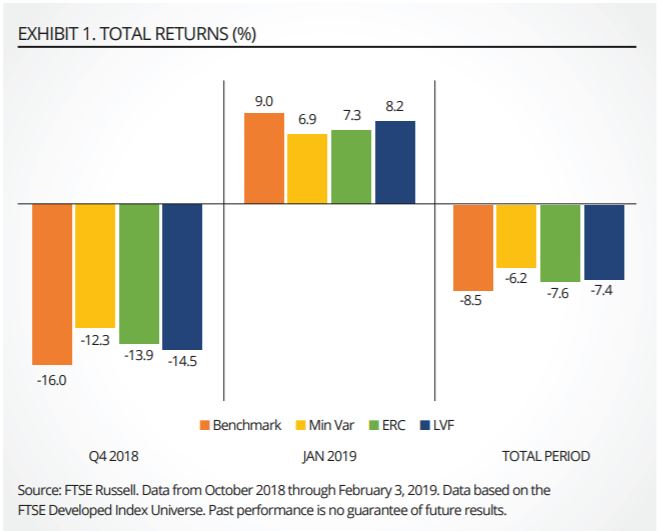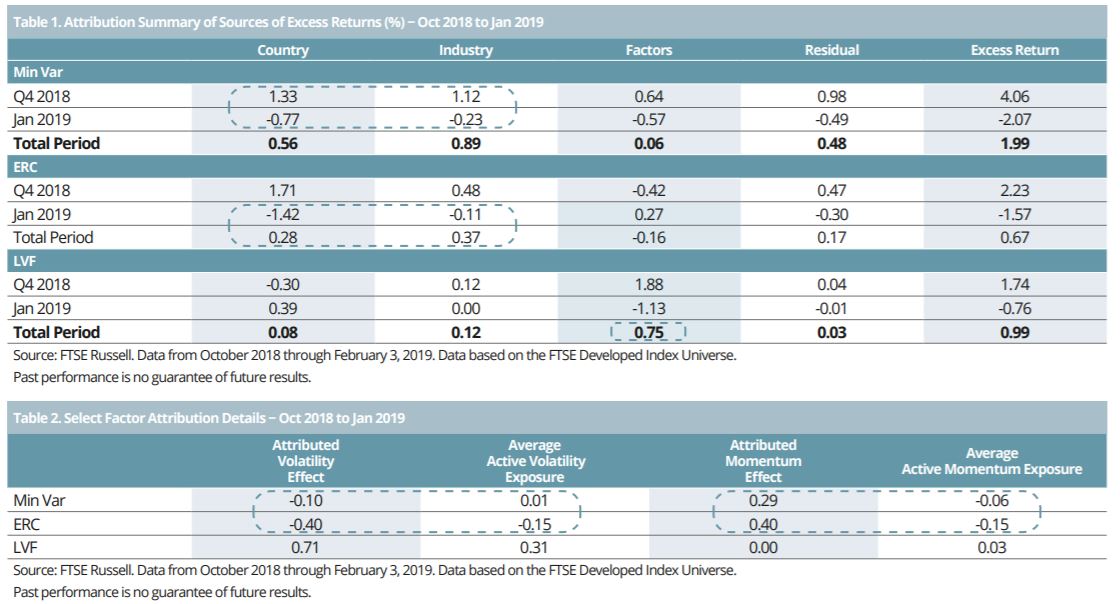Following the adverse market conditions in Q4 last year, Mark Barnes, managing director, head of US research at FTSE Russell, takes a look at which factors performed best during this more volatile period and whether it is worth seeking exposure to more defensive approaches.
The recent market turbulence has reawakened painful memories. It has also revived interest in defensive strategies that can provide long-term downside protection when markets fall without sacrificing much upside participation when they rise.
But not all defensive strategies are created alike – they have distinct objectives that have produced very different return patterns over time. The December meltdown and subsequent snapback offer a live test case of this point.
In our recent research paper we compare three popular defensive approaches based on back-tested FTSE Russell index data since September 2003: Minimum Variance (Min Var), Low Volatility Factor (LVF), and Equal Risk Contribution (ERC). They pursue very different goals:
• Min Var seeks to minimize portfolio volatility while maintaining sufficient diversification.
• LVF explicitly targets consistent exposure to the (low) Volatility factor.
• ERC portfolios are built so that each stock contributes equally to the overall portfolio volatility, with the aim of avoiding concentration risk.

To achieve these goals, each strategy employs its own implementation ground rules. As our research shows, even small differences in these methodologies can yield major differences in risk exposures and performance, especially over the short run. This was clearly the case in the most recent bout of market volatility.
As expected, all three defensive portfolios fell less than the benchmark (the FTSE Developed Index) in the Q4 downturn and rose less in the January rebound, outperforming for the full four-month span. Excess returns were highest for Min Var (at +2.2%), followed by LVF (+1.0%) and ERC (+0.85%).
Looking at participation ratios, Min Var was the most defensive of the three approaches (with participation ratios of 0.77 for both the Q4 and January 2019), meaning that it captured 77% of the broader market’s selloff in Q4 and 77% of the market’s rebound in January. By contrast, LVF was the least defensive (with respective ratios of 0.90 and 0.92), while ERC was in the middle, with respective ratios of 0.87 and 0.82.
Interestingly, Min Var’s similar participation ratios for both periods indicates that its outperformance came from the market not fully regaining lost ground. LVF, on the other hand, had a slightly positive participation difference (up minus down), meaning that it protected more on the downside than it gave up on the upside.
Therefore, if the market had completely recovered, LVF would have risen modestly, given these participation ratios. Meanwhile, ERC’s participation difference was negative.
Table 1 provides a more granular look at the sources of excess returns. Most of Min Var’s and ERC’s excess returns came from country and industry exposures, while very little came from factor exposure. By contrast, three-fourths of LVF’s excess return came from factor exposure.

CONSTRUCTION METHODOLOGY
This pattern makes sense given that both Min Var’s and ERC’s construction methodology revolve around portfolio risk, which acts to diversify country and industry exposures. For example, Min Var and ERC’s large exposures to Hong Kong added to excess returns, as did their overweights to Utilities. LVF’s comparatively smaller weight in Utilities had a neutral impact on excess returns, while its negligible exposure to Hong Kong detracted from relative performance.
Factor exposures can also make a big difference in performance (Table 2). LVF benefited from its large (and specifically targeted) exposure to the (low) Volatility factor, which outperformed the benchmark over this period. While Min Var is usually overweight (low) Volatility, its exposure was neutral during this period, hindering performance. The same goes for ERC, which had negative exposure to (low) Volatility. Another important factor was Momentum, which lagged the benchmark during the period. Min Var’s and ERC’s negative exposures to Momentum contributed to their outperformance.
In our research paper, we delved into how these strategies behaved during previous major market shocks, specifically the Global Financial Crisis, the Lehman Collapse, the European Credit Crisis and the China Growth Scare of 2015. Although all approaches provided meaningful downside protection during these episodes, they did so in ways specific to their makeup.
VOLATILITY REDUCTIONS
For example, during the preliminary global financial crisis sell-offs from November 2007 to March 2008, all three defensive portfolios provided relatively small reductions in volatility. Although they all benefited from industry diversification (for example, underweights to Technology and overweights to Utilities), Min Var and LVF held up better than ERC. This was mainly because of their positive exposure to the (low) Volatility factor, whereas ERC had negative exposure.
In the Lehman collapse from June 2008 to February 2009, our research shows that ERC was helped by its country diversification (for example, the overweight to Japan, which performed relatively well during that period). However, once again, ERC was underexposed to (low) Volatility, whereas Min Var and LVF were overweight. Moreover, exposures to (small) Size, which also performed well during part of this period, helped Min Var and ERC, but hurt LVF.
In the 2011 European Credit Crisis, we found that Min Var and LVF benefited considerably from their (low) Volatility exposure, but ERC had only a slightly positive active weight to the factor. ERC was also hurt by its sizable overweight to Japan and underweight to the US. As with the previous episode, Min Var’s exposure to Size and Volatility provided considerable downside protection during that episode. During the China Growth Scare from August 2015 to January 2016, ERC once again benefited from its underexposure to (low) Volatility. Size, on the other hand, benefited Min Var and ERC but hurt LVF. Again, ERC held large active weights in Japan and the US, which detracted from performance.
CONCLUDING THOUGHTS
These analyses underscore the effectiveness of defensive strategies to perform as expected during times of heightened volatility. As important, however, it reinforces how their differing objectives result in different exposures and, therefore, performance outcomes. It is important for investors to understand these differences when choosing the approach that can best address their investment needs.
Mark Barnes is managing director, head of US research at FTSE Russell
This article first appeared in the Q2 edition of our new publication, Beyond Beta. To receive a full copy, click here.



